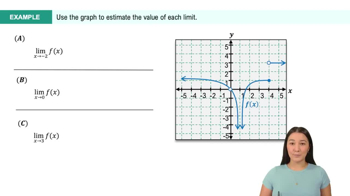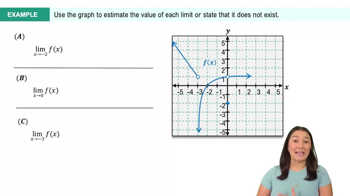Table of contents
- 0. Functions7h 52m
- Introduction to Functions16m
- Piecewise Functions10m
- Properties of Functions9m
- Common Functions1h 8m
- Transformations5m
- Combining Functions27m
- Exponent rules32m
- Exponential Functions28m
- Logarithmic Functions24m
- Properties of Logarithms34m
- Exponential & Logarithmic Equations35m
- Introduction to Trigonometric Functions38m
- Graphs of Trigonometric Functions44m
- Trigonometric Identities47m
- Inverse Trigonometric Functions48m
- 1. Limits and Continuity2h 2m
- 2. Intro to Derivatives1h 33m
- 3. Techniques of Differentiation3h 18m
- 4. Applications of Derivatives2h 38m
- 5. Graphical Applications of Derivatives6h 2m
- 6. Derivatives of Inverse, Exponential, & Logarithmic Functions2h 37m
- 7. Antiderivatives & Indefinite Integrals1h 26m
1. Limits and Continuity
Introduction to Limits
Problem 3
Textbook Question
The function s(t) represents the position of an object at time t moving along a line. Suppose s(2)=136 and s(3)=156 . Find the average velocity of the object over the interval of time [2,3] .
 Verified step by step guidance
Verified step by step guidance1
Identify the formula for average velocity over a time interval [a, b], which is given by the change in position divided by the change in time: \( v_{avg} = \frac{s(b) - s(a)}{b - a} \).
Substitute the given values into the formula. Here, \( a = 2 \) and \( b = 3 \), so the formula becomes \( v_{avg} = \frac{s(3) - s(2)}{3 - 2} \).
Use the provided position values: \( s(2) = 136 \) and \( s(3) = 156 \).
Substitute these values into the equation: \( v_{avg} = \frac{156 - 136}{3 - 2} \).
Simplify the expression to find the average velocity: \( v_{avg} = \frac{20}{1} \).
Recommended similar problem, with video answer:
 Verified Solution
Verified SolutionThis video solution was recommended by our tutors as helpful for the problem above
Video duration:
3mPlay a video:
Was this helpful?

 6:47m
6:47mWatch next
Master Finding Limits Numerically and Graphically with a bite sized video explanation from Callie
Start learning





